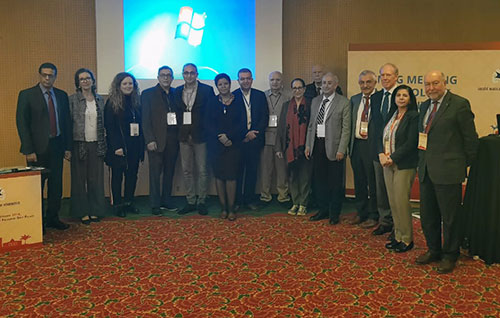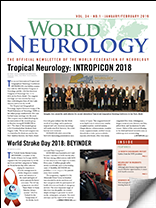by Prof. Mustapha El Alaoui Faris, Chair of the WFN Migrant Neurology Applied Research Group in Marrakech, Morocco
 The meeting of the World Federation of Neurology (WFN) Migrant Neurology Applied Research Group took place Dec. 14, 2018, in Marrakech, Morocco, during the 12th Maghreb Congress of Neurology. This meeting coincided with the meeting of the Intergovernmental Conference on the Global Compact for Migration, a United Nations meeting held Dec. 10-11, 2018, in Marrakech. The charter of the global alliance was adopted by the U.N. General Assembly on Dec. 19, 2018, and this constitutes real progress for the cause of migrant people.
The meeting of the World Federation of Neurology (WFN) Migrant Neurology Applied Research Group took place Dec. 14, 2018, in Marrakech, Morocco, during the 12th Maghreb Congress of Neurology. This meeting coincided with the meeting of the Intergovernmental Conference on the Global Compact for Migration, a United Nations meeting held Dec. 10-11, 2018, in Marrakech. The charter of the global alliance was adopted by the U.N. General Assembly on Dec. 19, 2018, and this constitutes real progress for the cause of migrant people.
The topics covered in this meeting included: “Migration and Global Health” (Mustapha El Alaoui Faris, Rabat, Morocco), “Neurology and Migration: What We Know, What We Learn by Neurosciences, What We Can Do” (Antonio Federico, Italy), “Vascular Risk Factors in Migrants” (Serefnur Ozturk, Turkey), “Neuroinfections in Migrants” (Erich Schmutzhard, Austria), “Multiple Sclerosis in Migrants” (Riadh Gouider, Tunisia), “Somatization in Migrants” (Maria Benabdeljlil, Morocco), and “Neuro-oncology and Palliative Care in Migrants” (Wolfgang Grisold, Austria). The following is a short summary of the communications.
Most human migration is in search of better opportunities, reflecting the desire for an improved quality of life. The current international migration is a reflection of the world, resulting from the dynamics generated by changes in political, economic, and cultural structures. It reflects the advent of an interdependent world, stimulating new cultural and economic exchanges, and contributing to the social reconfiguration of host and departure societies. Since the beginning of the 21st century, migration has changed. In the past, people migrated to survive; now they migrate to realize themselves. It is the educated middle classes with high human capital and skills who most migrate. Migration can also have political causes such as civil wars in some parts of the world, including the Middle East or sub-Saharan Africa. In the near future, two particular reasons will have a dramatic role in the migration of people around the world. First, climate change, which could create enormous refugee flows. The second is the world demographic imbalance between the number of people living in low- and middle-income countries and those living in high-income countries that are aging and have low fertility.
Studies on the health of migrants show that migrants have more health problems than the hosting populations. They are more vulnerable to communicable diseases but also to some noncommunicable diseases, such as hypertension, diabetes mellitus, or obesity. The majority of migrants are initially healthier than non-migrant populations, the so-called “healthy immigrant effect.”
The health vulnerability of migrants may be due to several factors, such as difficulties in early childhood (e.g., poverty and malnutrition), poor living conditions in the host country, and dangerous work and psychological problems related to the migration process. The prevalence of neurological diseases among migrants remains largely unknown. But, given the high prevalence of neurological diseases in low- and middle-income countries, where the majority of migrants are originating, a high frequency of diseases of the nervous system should be expected among migrants.
However, the incidence, prevalence, and clinical presentation of neurological diseases may differ in migrant people depending on the epidemiology, geography, and genetic background of the native country. Adult migrants who may have experienced early childhood deprivation are particularly vulnerable to subsequent disorders of the nervous system.
Here are the particularities of some neurological diseases in migrant people. Migrants have more infectious diseases. Tuberculosis, which can cause severe neurological complications, has seen a re-emergence among migrant people living in socioeconomically disadvantaged conditions in host countries. The prevalence of human immunodeficiency virus (HIV) is high in African migrants and may be resistant to HIV drugs, and these patients have more severe cognitive disorders. Some tropical infectious diseases (such as malaria or neurocysticercosis) may occur in host countries either in migrants or in tourists who have been living in areas of high prevalence of these diseases.
Stroke is a major public health problem among migrants given the high prevalence of vascular risk factors such as hypertension, diabetes mellitus, obesity, and smoking. Migrants can have severe strokes at a younger age with high mortality rates and persistent neurological disability for a long time. In some host countries, migrants with cerebrovascular diseases appear to be less likely to benefit from appropriate treatment such as thrombolysis or thrombectomy.
Studies on the epidemiology of multiple sclerosis (MS) have shown that migration at the beginning of life from a low-risk area to a high-risk area can increase the risk of MS in this migrant population. Likewise, MS in some migrants is much more severe than in the native population (such in North Africans living in France).
Somatization and functional neurological disorders are common among migrant people, and their clinical presentation depends on the native culture of the migrants.
The severity of some neurological diseases that reduce the life expectancy of patients, such as neuro-oncological disorders, raises the problem of palliative care of migrant people. Palliative, hospice, and end-of-life care can be incompatible with culture and religious beliefs of some migrants and requires an appropriate approach.
The WFN Migrant Neurology Applied Research Group plans more meetings dedicated to other neurological diseases in migrant people, such as cognitive disorders in elderly migrants, epilepsy, neurogenetics, migraines and headaches, neuromuscular diseases, movement disorders, anxiety, and depression. •
